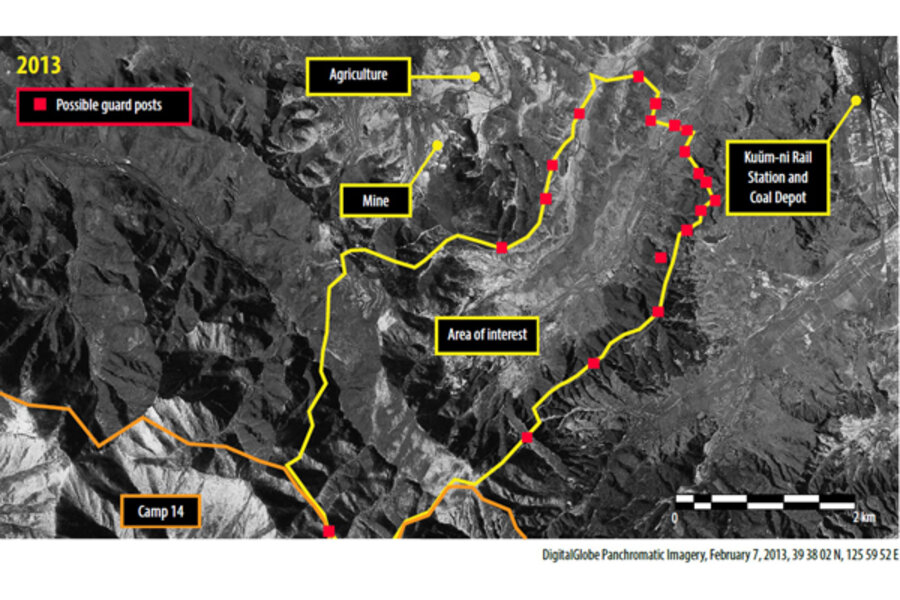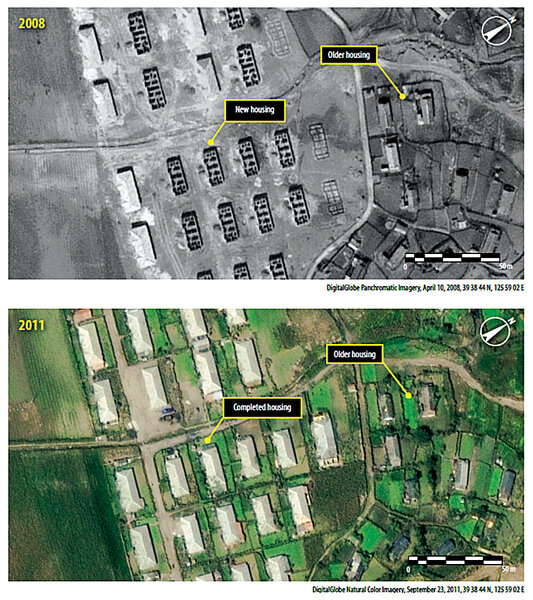North Korea's hidden labor camps exposed
Loading...
Even with new leader Kim Jong-un at the helm, North Korea remains the most reclusive and closed country in the world: It is a police state inside a totalitarian system ruled by a family dynasty that encourages a cultish ideology and following.
The regime controls everything. There is no free speech, free trade, fair court, no Fox News or MSNBC equivalent. Outsiders are not permitted to freely travel inside; it is a crime for citizens to leave their hometowns, let alone the country, without permission. Obedience is nonnegotiable. There are four secret police services. And informants are everywhere. At the mere suspicion of dissent, a person or a whole family can simply "disappear."
What North Korea hasn't been able to control, however, is the sky above it. In recent years, satellite photos have revealed a network of brutal prison labor camps, a gulag system hidden for decades, mostly in the mountains, housing as many as 200,000 prisoners, with some camps as big as small US cities.
Yet now those satellite images – along with newly compiled troves of testimony by former gulag inmates who have managed to defect – will form the basis of something quite new and potentially earthshaking for the Korean Peninsula: On March 21, the United Nations ended years of inaction and set up a "commission of inquiry" to examine systematic "crimes against humanity" in North Korea.
Prisons modeled on Stalin's
After the end of the Soviet Union and the opening of China, things like gulags were thought to be over. The word seems a relic from the 1950s, made famous by the works of Aleksandr Solzhenitsyn – referring to freezing places in Siberia of torture and execution. But they still exist in North Korea, where witnesses describe children beaten to death and routine starvation.
"Virtually every legal scholar and former tribunal judge looking at North Korea has come to the conclusion that these are massive crimes against humanity," says David Hawk, a veteran of Cambodia and Rwanda genocide studies and author of the definitive 2012 report on North Korea, "The Hidden Gulag." "What comes next in the process is a UN inquiry, and that's where we are."
A UN panel report by three prominent judges and diplomats from Australia, Indonesia, and Serbia may indeed pressure the Security Council to refer North Korea to the International Criminal Court (ICC), and lead to an indictment of its leaders. A UN attempt to hold the North to "full accountability" for mass crimes may alter the chemistry among East Asian states. It may also have ramifications for the North's main bankroller, China, which has been sending Korean refugees back to the North where they can end up in prison camps simply for leaving the country.
Some analysts hope the inquiry will force a shutdown of the gulag. A mere UN inquiry may sound pallid. But for a North Korea that rules by fear, it may in time create great pressure for the country to do what for years it has avoided: change.
Yet some defectors and gulag survivors worry that the very act of trying to shine a bright public light into the dark corridors of the North could lead the Kim regime to kill the current denizens of the gulag, to "eliminate the evidence."
North Korea itself has always fiercely denied the existence of the camps and says it has no political prisoners. There are "no human rights violations in our people-centered socialism," is the official position. The North takes this stand despite photo imagery of electric fences and watchtowers, of precise GPS locations, and with former inmates and guards able to pick out in photos the very prison barracks they say they lived in.
Defectors are an increasing source of information and have played a role in changing minds at the UN. Largely on the strength of more numerous inmate defectors, including figures like Shin Dong-hyuk who was born in Camp 14 and escaped in 2005 (see sidebar), a fuller picture of the sheer scale of the gulag is emerging.
(Read more about Shin Dong-hyuk who was born in Camp 14)
There are estimated to be at least 16 camps ranging from those with 3,000 people to others with 50,000. Six camps called kwan-li-so are purely for political pris-oners. Another seven or eight called kyo-hwa-so house a mix of political and ordinary felons. And of late, a plethora of "interrogation centers" have sprung up where Koreans are held and "reeducated" for as long as six months. (Such centers grew exponentially after the famine of the mid-1990s, as Koreans crossed into China for food and aid and were often returned by Chinese police.)
The longevity of the camps is unique. While the gulags of Stalin and to a lesser extent Mao ended within five years of their deaths, the Korean gulag continues on as a macabre Kim family tradition – built in the late 1950s and handed down from North Korea's founding father Kim Il-sung to his son the "Dear Leader" Kim Jong-il to new "Supreme Leader" Kim Jong-un.
North Korea has "the worst human rights government extant," says Marcus Noland at the Peterson Institute in Washington. "There are places in the world where things are horrible, failed states, Somalia, Eastern Congo, places where there is no government and things go wild. But this is a country that guards its borders and is not falling apart and that systematically ... starves people to death in a very hard and ruthless system."
Over the years, the number of unnatural deaths in gulag detention may run to 100,000 or more.
"Over and over [in testimony of escaped prisoners] you hear that the death rates in the camps are astounding," says Greg Scarlatoiu, executive director for the Committee of Human Rights in North Korea. "A third to half the people who arrive are later gone after forced labor, beatings, illness.... The big question is whether the number of newly arrived prisoners is making up for the deaths of current prisoners," he says.
It is camp policy to underfeed and overwork gulag inmates. Prisoners stay alive by finding lizards, rats, and mushrooms, and go hungry even in camps that export vegetables to Pyongyang.
"Without variation, each meal consisted of 14 beans per meal with powdered corn," offers a Mrs. Bang in Mr. Hawk's report. Others describe how they picked through animal feces to find undigested corn kernels in order to survive. Torture, beatings, and executions are common. Labor is unpaid, 12 to 14 hours a day, seven days a week with one "rest day" off per month.
Sentenced for 'wrong thinking'
Koreans can be sent "to the mountains," as it is known, for crimes of "wrong thinking." These might range from criticism of the Kim family to attempting to leave the country, professing religious faith, humming a South Korean song, or being born of mixed race or to a family that has had members deemed insufficiently loyal.
According to Kim family crime theory, three generations may be punished before the family is considered cleansed of an infraction.
"In a lot of these cases, they take the whole family, grandparents, you have kids being sent to camps," says Roberta Cohen of the Brookings Institution who recently gave congressional testimony on the camps. "Those children ... they should not be there."
Camp management has changed little over the decades. Hawk, surveying prison-defector testimony dating to 1970, says change is mainly seen on the margins, in rituals, for example: "We used to hear about public executions where prisoners were later required to walk by and stone or strike the corpse. This was standard in descriptions of camp life two decades ago, but not lately. Public executions are still seen by every prisoner; but the practice of compulsory defilement may have stopped."
Still, Hawk says, "Recent testimony suggests nothing is different.... The barbaric nature of these places has not changed."
UN inquiry raises profile
Ten years ago conditions in the Korean gulag were protested by figures like Czech poet-president Václev Havel. But because the camps were hidden and officially denied, with few witnesses and often ignored by a South Korea trying to pursue a "Sunshine Policy" of engagement and rapprochement with the North – there never seemed to be much international outcry.
Part of the reason, say some, is the lack of a high-profile face lobbying for change. The genocide in Darfur had George Clooney to raise awareness, and orphans had Angelina Jolie. But "we don't have a movie star," says Ms. Cohen.
Yet with the UN inquiry, new and diverse lights are starting to shine on one of the darkest places on earth. For one thing, there is a more critical mass of defector testimony. A decade ago only some 3,000 North Koreans had escaped and made it to tell their stories in the South; today the number is around 25,000.
For the first time the US envoy to North Korea, Glyn Davies, has met defectors and emphasized that human rights are as important as the North's nuclear program. Leading South Korean politicians are speaking about mass crimes against civilians in the North.
In another first, UN human rights chief Navi Pillay met with gulag survivors in December on the grounds that they had been ignored too long, and she helped lead the 47-member UN Human Rights Council in Geneva to vote unanimously for the inquiry.
"Because of the enduring gravity of the situation," Ms. Pillay said in January, "an in-depth inquiry into one of the worst – but least understood and reported – human rights situations ... is long overdue."
Since 2004 an unpaid, part-time UN envoy has looked into North Korea. But the new inquiry will fund three professionals plus a staff of nearly a dozen.
As the UN inquiry proceeds, the panel will employ a legal focus developed through the Rome Statutes of 1999. The statutes were used to inform the creation of the ICC and its standards of indictment.
Before 1999, "crimes against humanity" were considered atrocities against civilians in time of war. But the North Korean inquiry will employ the expanded Rome Statutes, which define atrocities and "grave violations" against civilians as prosecutable in peace and war.
In international legal terms, this is not good news for Pyongyang. The regime will be investigated for standard recognized crimes like execution, torture, and starvation. But under the Rome laws, the North will also be examined for practices peculiar to itself, and so heinous, as Cohen puts it, that "no terminology has been devised" to describe them.
The panel will look at questions of rape and sexual violence, and practices of infanticide. Numerous survivor testimonies describe pregnant women forced into abortions or given labor-inducing drugs, after which the children are killed. Many cases involve women trafficked in China, caught, and sent back; their babies were suffocated on racial grounds – the infants were half Chinese in a country that prefers "pure race" Koreans. The North's practice of incarcerating entire families, and of holding prisoners incommunicado for years, will also be examined.
The panel will also look at cases of brutality against those professing religious faith, usually Christianity.









